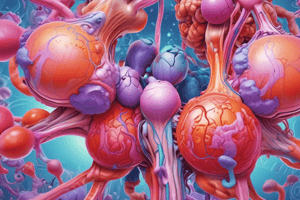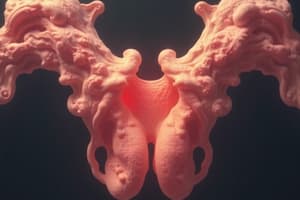Podcast
Questions and Answers
What percentage of thyroid hormone output does T3 represent?
What percentage of thyroid hormone output does T3 represent?
- 75%
- 90%
- 10% (correct)
- 50%
The thyroid gland is located above the larynx and posterior to the trachea.
The thyroid gland is located above the larynx and posterior to the trachea.
False (B)
What hormones do follicular cells of the thyroid gland produce?
What hormones do follicular cells of the thyroid gland produce?
Thyroid hormones (T3 and T4)
The thyroid gland is shaped like a ______.
The thyroid gland is shaped like a ______.
Match the thyroid hormones with their respective contributions:
Match the thyroid hormones with their respective contributions:
Which of the following substances is necessary for the synthesis of thyroid hormones?
Which of the following substances is necessary for the synthesis of thyroid hormones?
Calcitonin is produced by follicular cells of the thyroid gland.
Calcitonin is produced by follicular cells of the thyroid gland.
What role does the hypothalamus play in the secretion of thyroid hormones?
What role does the hypothalamus play in the secretion of thyroid hormones?
What hormones are secreted by the adrenal medulla in response to stress?
What hormones are secreted by the adrenal medulla in response to stress?
The pancreas functions solely as an endocrine gland.
The pancreas functions solely as an endocrine gland.
What role does glucagon play in blood glucose regulation?
What role does glucagon play in blood glucose regulation?
The main hormone secreted by the pineal gland is __________.
The main hormone secreted by the pineal gland is __________.
Match the hormone with its gland:
Match the hormone with its gland:
Which of the following hormone-secreting cells in the pancreas decreases blood glucose levels?
Which of the following hormone-secreting cells in the pancreas decreases blood glucose levels?
Epinephrine and norepinephrine are released during a non-stressful situation.
Epinephrine and norepinephrine are released during a non-stressful situation.
What is the function of calcitonin?
What is the function of calcitonin?
What is the primary function of thyroid hormones?
What is the primary function of thyroid hormones?
Hypothyroidism can lead to high metabolic rates.
Hypothyroidism can lead to high metabolic rates.
What condition results from an excessive secretion of thyroid hormones?
What condition results from an excessive secretion of thyroid hormones?
The major mineralocorticoid produced by the adrenal cortex is _____ .
The major mineralocorticoid produced by the adrenal cortex is _____ .
Match the following hormones to their primary functions:
Match the following hormones to their primary functions:
Which of the following symptoms is NOT associated with hyperthyroidism?
Which of the following symptoms is NOT associated with hyperthyroidism?
Calcitonin is secreted by the C cells of the parathyroid glands.
Calcitonin is secreted by the C cells of the parathyroid glands.
What is the main effect of hypoparathyroidism?
What is the main effect of hypoparathyroidism?
___ are the two adrenal glands located one above each kidney.
___ are the two adrenal glands located one above each kidney.
Which of the following conditions is characterized by low blood pressure and dehydration due to a deficiency of adrenal cortex hormones?
Which of the following conditions is characterized by low blood pressure and dehydration due to a deficiency of adrenal cortex hormones?
Androgens produced in the adrenal cortex primarily affect men.
Androgens produced in the adrenal cortex primarily affect men.
What is the physiological effect of glucocorticoids during stressful situations?
What is the physiological effect of glucocorticoids during stressful situations?
Parathyroid hormone is responsible for increasing the level of _____ in the blood.
Parathyroid hormone is responsible for increasing the level of _____ in the blood.
What stimulates the secretion of Calcitonin?
What stimulates the secretion of Calcitonin?
Match the following conditions to their respective hormone imbalances:
Match the following conditions to their respective hormone imbalances:
Flashcards
Where is the thyroid gland located?
Where is the thyroid gland located?
The thyroid gland is a butterfly-shaped organ located below the larynx and in front of the trachea. It has two lobes connected by a bridge-like isthmus.
What are the structures within the thyroid gland?
What are the structures within the thyroid gland?
The thyroid gland is made up of tiny structures called thyroid follicles. The walls of these follicles contain two types of cells: follicular cells and parafollicular cells.
What are the functions of the cells within the thyroid follicles?
What are the functions of the cells within the thyroid follicles?
Follicular cells are responsible for producing thyroid hormones, which regulate metabolism. Parafollicular cells produce calcitonin, a hormone that helps regulate calcium levels in the blood.
How are thyroid hormones made and stored?
How are thyroid hormones made and stored?
Signup and view all the flashcards
How are thyroid hormones transported in the body?
How are thyroid hormones transported in the body?
Signup and view all the flashcards
What triggers the release of TRH?
What triggers the release of TRH?
Signup and view all the flashcards
What does TRH do?
What does TRH do?
Signup and view all the flashcards
What does TSH do?
What does TSH do?
Signup and view all the flashcards
Adrenal Medulla Hormones
Adrenal Medulla Hormones
Signup and view all the flashcards
Epinephrine (adrenaline)
Epinephrine (adrenaline)
Signup and view all the flashcards
The Pancreas
The Pancreas
Signup and view all the flashcards
Pancreatic Islets
Pancreatic Islets
Signup and view all the flashcards
Alpha Cells and Glucagon
Alpha Cells and Glucagon
Signup and view all the flashcards
Beta Cells and Insulin
Beta Cells and Insulin
Signup and view all the flashcards
Ovary Hormones
Ovary Hormones
Signup and view all the flashcards
Testes Hormone
Testes Hormone
Signup and view all the flashcards
Hyperthyroidism
Hyperthyroidism
Signup and view all the flashcards
Hypothyroidism
Hypothyroidism
Signup and view all the flashcards
Calcitonin
Calcitonin
Signup and view all the flashcards
Parathyroid glands
Parathyroid glands
Signup and view all the flashcards
Parathyroid hormone (PTH)
Parathyroid hormone (PTH)
Signup and view all the flashcards
Hypoparathyroidism
Hypoparathyroidism
Signup and view all the flashcards
Hyperparathyroidism
Hyperparathyroidism
Signup and view all the flashcards
Adrenal glands
Adrenal glands
Signup and view all the flashcards
Adrenal cortex
Adrenal cortex
Signup and view all the flashcards
Mineralocorticoids
Mineralocorticoids
Signup and view all the flashcards
Glucocorticoids
Glucocorticoids
Signup and view all the flashcards
Androgens
Androgens
Signup and view all the flashcards
Cushing's syndrome
Cushing's syndrome
Signup and view all the flashcards
Addison's disease
Addison's disease
Signup and view all the flashcards
Study Notes
Endocrine System Overview
- The endocrine system is a complex network of glands that release hormones into the bloodstream to regulate various bodily functions.
- Visual aids (images) show various thyroid conditions and endocrine glands.
- Learning objectives are to describe the locations, hormones, and functions of specific endocrine glands.
Thyroid Gland
- The butterfly-shaped thyroid gland is located below the larynx and in front of the trachea.
- It has two lobes connected by an isthmus.
- The thyroid gland is highly vascular.
- The thyroid gland consists of follicles, with follicular cells producing thyroid hormones. Parafollicular cells (C cells) produce calcitonin.
Thyroid Hormones
- The thyroid gland produces two types of hormones: T3 (triiodothyronine) and T4 (thyroxine or tetraiodothyronine).
- T4 constitutes 90% of thyroid output.
- T3 is responsible for the majority of the thyroid hormone's tissue actions.
- Thyroid hormones are synthesized from iodine and tyrosine.
- Iodine sources include sea fish, bread, vegetables, and milk.
Thyroid Hormone Secretion
- Low thyroid hormone levels or low metabolic rate trigger the hypothalamus to release thyroid-releasing hormone (TRH).
- TRH travels to the anterior pituitary, which then releases thyroid-stimulating hormone (TSH).
- TSH stimulates the thyroid follicular cells, which release T3 and T4 hormones into the blood, maintaining normal metabolic rates.
- Elevated T3 and T4 levels inhibit further TRH and TSH release (negative feedback).
Thyroid Hormone Function
- Thyroid hormones increase the basal metabolic rate (BMR).
- They contribute to body temperature maintenance.
- They stimulate protein synthesis.
- They increase the use of glucose and fatty acids for ATP production.
- Along with growth hormone and insulin, they stimulate body growth in nervous and skeletal systems.
Clinical Applications (Hyperthyroidism)
- Hyperthyroidism involves an enlarged thyroid gland and excessive thyroid hormone production.
- It frequently leads to toxic goiter and Graves' disease.
- Symptoms include elevated metabolic rate, hyperactivity, insomnia, nervousness, irritability, and chronic fatigue.
Clinical Applications (Hypothyroidism)
- Hypothyroidism is a deficiency or lack of thyroid hormones.
- In infants, it can cause cretinism, leading to mental retardation and skeletal abnormalities.
- In adults, it can lead to myxedema, presenting as symptoms like low heart rate, low body temperature, sensitivity to cold, dry skin and hair, muscular weakness, lethargy, and weight gain.
Calcitonin
- Parafollicular cells (C cells) in the thyroid gland secrete calcitonin.
- Calcitonin inhibits osteoclast activity, lowering blood calcium levels.
- Blood calcium levels regulate calcitonin secretion.
Parathyroid Glands
- These glands are embedded in the posterior surfaces of the thyroid lobes, two to each lobe.
- Parathyroid glands contain chief cells, which produce parathyroid hormone (PTH).
Parathyroid Hormone (PTH) Function
- PTH is a major regulator of blood calcium, magnesium, and phosphate levels.
- It increases osteoclast activity, releasing calcium ions from bone matrix and regulating phosphate reabsorption rate in urine.
- PTH promotes calcitriol formation, stimulating Ca2+, Mg2+, and phosphate absorption from the gastrointestinal tract.
- Hypoparathyroidism and hyperparathyroidism are disorders related to PTH secretion imbalances.
Adrenal Glands
- Paired adrenal glands, superior to each kidney, consist of an outer cortex and inner medulla.
- The adrenal cortex produces steroid hormones, all derived from cholesterol.
- Zones within the adrenal cortex secrete specific groups of hormones: mineralocorticoids, glucocorticoids, and androgens.
Mineralocorticoids
- Mineralocorticoids, primarily aldosterone, are produced in the zona glomerulosa of the adrenal cortex.
- They regulate sodium and potassium levels in response to dehydration.
- They increase sodium reabsorption and water retention.
- They decrease potassium reabsorption and promote potassium excretion in the urine, helping control blood pressure.
- The renin-angiotensin-aldosterone pathway controls aldosterone secretion.
Glucocorticoids
- Glucocorticoids, mainly cortisol, are produced in the zona fasciculata of the adrenal cortex.
- They are vital for glucose metabolism in stressful situations.
- Glucocorticoids promote glucose formation, stimulate protein breakdown, increase fat breakdown, and have anti-inflammatory effects.
- ACTH (adrenocorticotropic hormone) regulates cortisol secretion, working through a feedback loop.
Adrenal Androgens
- Adrenal androgens are produced by the zona reticularis, impacting libido in females, with minimal effects in males.
Clinical Applications (Adrenal Glands)
- Cushing's syndrome is characterized by excess glucocorticoid secretion, leading to hyperglycemia, edema (swelling), and potassium loss.
- Addison's disease results in insufficient glucocorticoid and mineralocorticoid secretion. Typical symptoms include hypoglycemia, sodium loss, low blood pressure (BP), dehydration, and muscle weakness.
Adrenal Medulla
- The adrenal medulla secretes epinephrine (adrenaline) and norepinephrine (noradrenaline).
- These hormones create responses mimicking the sympathetic nervous system.
- Secretion is triggered by stressful situations (fight-or-flight response).
Pancreas
- The pancreas is both an endocrine and exocrine gland.
- It is located behind and slightly below the stomach.
- The pancreas contains pancreatic islets (islets of Langerhans), which consist of alpha (α) and beta (β) cells.
Pancreatic Hormones
- Alpha cells secrete glucagon, increasing blood glucose levels.
- Beta cells secrete insulin, decreasing blood glucose levels.
Gonadal Hormones
- Ovaries produce estrogens, progesterone, inhibin, and relaxin, regulating the menstrual cycle, maintaining pregnancy, and preparing mammary glands for lactation, establishing and maintaining secondary sex characteristics in females.
- Testes produce testosterone (an androgen), regulating sperm production and developing and maintaining secondary sex characteristics in males.
Pineal Gland
- The pineal gland, located near the roof of the third ventricle of the brain, secretes melatonin.
- Melatonin regulates the biological clock, impacting seasonal and daily cycles.
Thymus Gland
- The thymus gland secretes thymosin, promoting T-cell proliferation and maturation.
- T cells are crucial to the immune response, destroying microorganisms and foreign substances.
Recap/Quiz (multiple topics)
- Presented in a question-and-answer format, summarizing key facts about various endocrine functions and related diseases like goiter, Graves' disease, cretinism, myxedema, Cushing's syndrome, and Addison's disease.
Studying That Suits You
Use AI to generate personalized quizzes and flashcards to suit your learning preferences.




